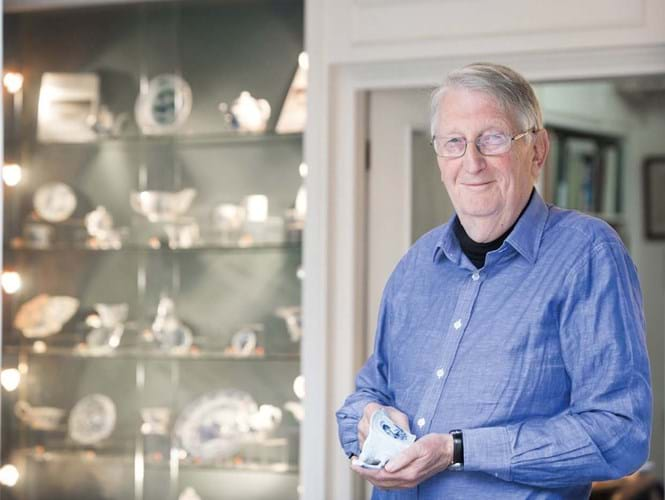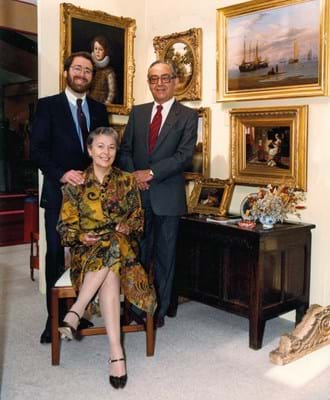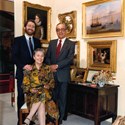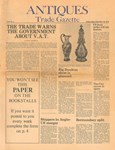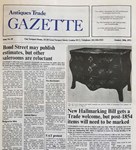Sharing knowledge
Yes, I remember 1971 well. All too well in fact.
As a young ceramics dealer, hardly yet established, I was struggling against the onset of what was proving to be the most threatening recession of my entire career.
The face of the antiques trade was changing; a process facilitated by the inception of Antiques Trade Gazette.
A fresh generation of dealers was emerging and long-established traditions were becoming blurred as the distinction between dealer and collector, professional and amateur, was gradually eroded, eventually to the benefit of both.
Until this period, auctions of antiques, especially those in London and other cities, were primarily the realm of dealers. At the principal London auction houses, Sotheby’s, Christie’s and Phillips, Son and Neale, collectors seldom participated in person and details of provincial auctions were not widely circulated.
Dealers seemed to be a separate species from collectors, deeply protective of their sources, the mainspring of which were the auction houses.
The launching of the ATG in September 1971, was initially received with widespread alarm by the majority of the antiques trade, as a threat to their livelihood.
Revealing prices
In publishing details of forthcoming auctions, particularly in the provinces and most of all, the prices attained, it seemed as though a curtain was being drawn aside, throwing a light on aspects of the arcane practices of the working life of the antiques dealer of that era.
The long distances travelled to view and attend country auctions, the deep-rooted levels of inter-dealing and for a significant and sometimes poorly catalogued piece, the convoluted passage from its original purchase at auction to its eventual appearance at a prestigious antiques fair.
There were several tiers of dealers, some of whom sold only to fellow members of ‘the Trade’.
Knowledge and expertise were hard earned, closely guarded and not to be shared, especially with potential customers.
I learnt this to my cost on the publication of my first book, The Price Guide to Eighteenth Century English Porcelain in 1970, regarded by some as a betrayal of the dealer’s ethos. Whereas I naively considered dealers and collectors as mutually supportive, to many colleagues the sharing of knowledge and most especially values was anathema.
On a more personal level, I shall always be appreciative of the promotional support which I invariably received for my various enterprises, including book reviews, porcelain seminars and later, the collaborative venture Eight Days in June.
Furthermore, I was fortunate for over 30 years in the coverage of my annual ceramic exhibitions, with loyal and hardy customers queuing outside my shop, sometimes for two days or more; I especially appreciated the detailed ATG reports of my accompanying catalogues.
ATG, in its coverage of so many aspects of the art market, has been instrumental in raising the profile of the antiques dealer and mitigating a certain sense of wariness which at one time existed between dealer and collector. It has also instigated a sense of the antiques market as a community rather than merely a grouping of disparate and often idiosyncratic individualists.
The ATG has served to provide a vehicle for the individual dealer, the collector and the market as a whole; a symbiotic relationship which perhaps embodies its most enduring legacy.
A huge benefit
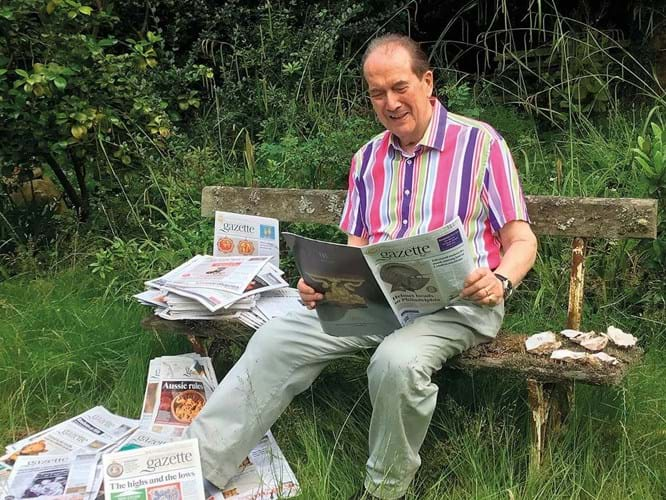
David Barrington, the long-standing dealer for antique dolls and juvenilia works his way through a mountain of ATGs on his staycation.
I had always had an interest in antique dolls and toys and when I started in the trade in 1970 I was still a practising lawyer. Divorce and medical negligence were my specialist subjects and, my gosh, they were tough compared to dealing in juvenilia.
I found immediately that the Gazette was an enormous help and a fount of information.
As a specialist dealer, finding the right stock was more difficult than selling. A prime source was auction houses and in those days I had to either phone or send a letter to gain information. Getting a good photo and detailed description tended to be a problem; a hairline crack to a bisque doll’s head made a great difference to its value. Auctioneers were helpful but could not always get it right. That’s why I tried to view the items personally.
When the ATG started in September 1971 it was a huge benefit to me as it listed many auctions I did not know about and I had much more scope for buying.
Trade was much different in the ‘70s and ‘80s than today. I had rented a shop in the Mall and later in the Angel Arcade at Camden Passage dealing in antique dolls and toys.
Buzzing area
The area was buzzing on Wednesdays and Saturdays and so was I. There was no worry about selling; an orderly queue of dealers was waiting outside my shop already when I arrived at 6.30 early in the morning and by lunchtime the goodies that I had freshly brought in were all sold, just like in any trendy bakery on Upper Street today.
My 35 years in Camden Passage were never boring and brought the world to me. Dealers and collectors came from all over the globe, as did Hollywood stars and celebrities, often unrecognisable in real life.
Trade became slower by the end of the ‘90s and Camden Passage sadly lost many of its old dealers.
Today, at a vintage age of 79, I am still an avid reader of the Gazette. Throughout its 50 years the ATG has been a wonderful source of business and pleasure.
May we both continue for a long time , just like well-kept antiques.
David Barrington (subscriber 161)
Still trading and loving it
Memories of the 1960s/70s? Yes indeed!
I left school in 1962 and started work with my father – a well-known and respected provincial dealer based in Lincoln. My father was ‘old school’ – he bought me a £12 suit in Burtons, gave me 30/- (£1.50) per week and I lived at home.
Needless to say I was given all the nasty ‘jobs’ to do, eg stripping sets of yew-wood Windsor chairs of their varnish etc (he always kept a stock of at least six matching sets of the best chairs!).
Planning the week ahead
However, getting to the main reason for this letter – the job I resented the most was visiting Lincoln public library every Saturday morning and scouring all the newspapers, local and countrywide, and having to list all the upcoming auction sales in my ‘auction book’ which my father would then peruse in order to plan his week.
This tedious and time-consuming job ate into the weekend social life – mainly getting up when I felt like it and walking into Lincoln to meet my mates (and hopefully a girlfriend) and visit the record shop, where we would take in the latest hit records, have a burger in the Wimpey bar and then get ready for playing football for my team or, if we didn’t have a match, we’d scrounge the money somehow to see (2nd division) Lincoln City – aka The Imps!
The point of this letter was that I was nine years too early for ATG – the amazing antiques newspaper that actually listed all these sales.
Consequently I was always late for everything on my favourite ‘day off’, the previous Saturdays.
Looking back, I (belatedly) realised that everyone else now also knew about these sales including our local ‘secret salerooms’, but, c’est la vie as they say.
Many thanks for giving me the opportunity to write this letter and I hope to see it published – it would make my day.
Robin Cox
Robin Cox Antiques, Stamford, Lincolnshire
PS still trading and loving it – long may it last!
All in one place
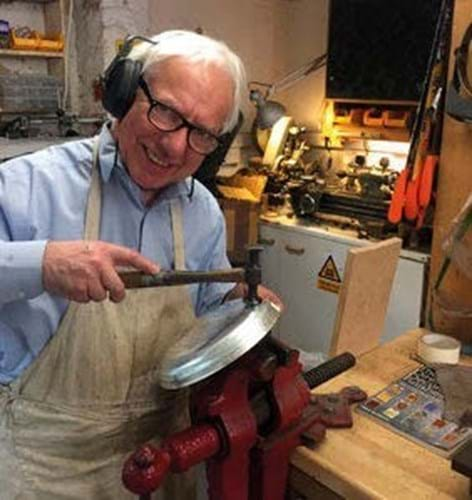
Precious metals dealer Michael Bloomstein of Brighton.
Precious metals dealer Michael Bloomstein of Brighton has been a reader of ATG since the very early days. He has also provided the weekly precious metals prices which we have quoted in every issue since 1979.
“I first heard of the Gazette soon after it appeared when doing the rounds in Brighton. I was working in the family business with my uncles dealing in silver and plate and can remember going into Winny Asher’s shop in Bedford Street (near The Lanes) who mentioned a new magazine had come out… so I took a look.
“It was all black and white back then but I found the images interesting and the articles very informative.
“I started subscribing as I found it helpful both in terms of dealing and also broadening one’s knowledge especially about other fields like furniture and jewellery.
“The Gazette made a huge practical difference. Beforehand we used a publication called ‘The List’ to find out what was selling where and we also had to check through reams of adverts in local and national newspapers. The Gazette’s calendar changed all that and the lot descriptions in the adverts were often more than the cursory few words in other publications.
“It was also helpful to have a weekly summary of prices from auctions to get a sense of the latest market values. Previously we relied on the Lyle price guides, published by Tony Curtis, and the Miller’s guide, that came out once a year. The Gazette made a big difference in this regard.
“With the lists of upcoming fairs too, the Gazette published the whole lot that dealers needed all in one place. This is why it’s always been really the only newspaper for the trade.
Conversation starter
“The Gazette also creates topics of conversation. I can remember going into the greasy spoon in Bermondsey Market and seeing dealers looking through the Gazette saying ‘this sold too cheaply’ or ‘I had one of those recently… I should have kept it!’
“In terms of the precious metals prices published each week, I hope readers have benefited from being aware of these prices and that they continue to provide a useful indication of the market for dealers and collectors across the country.”
The game changer
As a university student I went for an interview with [the late] Richard Came, then head of the silver department at Sotheby’s, in September 1971. He showed me the first edition of the ATG and said that he thought it would change the entire antiques trade.
At the time I was surprised at what Richard said – but, of course, he was correct in his prophesy.
Peter Cameron, silver dealer
A friend indeed
I first took the ATG in 1973. I spotted the Bonhams advert in a November 1975 edition. I joined as a porter in the ceramics department and I eventually became a director and board member.
I think of Antiques Trade Gazette as a friend. It has always been there. I always say to people they should read ATG to know what is going on.
Eric Knowles
Decorative arts and Antiques Roadshow specialist
A cut above
While congratulating you on your 50th anniversary, please spare a thought for Romeike & Curtice*, press-cutting agency, who sent us all the catalogue notifications pre ATG.
Hugh C Mote (subscriber to ATG for 50 years!)
* we did spare a thought for Romeike & Curtice by doing a quick internet search for the firm’s name. It successfully outlived the Gazette’s arrival and was acquired by a Swedish company called Observer in 1999 which later rebranded as Cision, a firm going strong today.
Sparkling memories
I can remember as a teenager having to rush photographs over to an office inhabited by the late David Moss, who worked first for Art and Antiques Weekly before he later joined Antiques Trade Gazette.
David was always looking for good quality colourful images and we would quite often adjourn from his domain next to Charing Cross Station to a nearby wine cellar which had a royal licence to serve alcohol to weary travellers at any time of the day or night! Champagne was the drink of choice.
I know David Moss gave his life to his work along with Ivor Turnbull and I can remember so many happy conversations with others from the ATG over the years.
David Harvey
Managing director, WR Harvey & Co (Antiques)
Witney, Oxfordshire
Setting the agenda

John Day of the East Anglian Traditional Art Centre.
In the early 1970s I ran Eastbourne Fine Art, a gallery specialising in Norwich and Suffolk School paintings.
Successful exhibitions were held, and we exhibited at well-established antiques fairs, including Brighton and Snape Maltings in Suffolk.
Finding stock was difficult. We operated a network of ‘spotters’ with auction catalogues arriving from around the world.
Apart from the top London sales, these were sparsely illustrated. Sotheby’s Belgravia set a trend with more illustrations, black and white in those days, and country auction house catalogues sometimes ran to a plate or two.
We appointed an enthusiastic researcher to go through local papers spotting adverts for auctions and writing off for catalogues. If anything was of interest occasionally a Polaroid photo could be obtained by post but it was really a matter of planning to view in person.
When Antiques Trade Gazette was launched in 1971 my assistant’s job became much easier and we had Saturday morning meetings to assess the next week’s activities.
Remarkable price changes have been witnessed, mainly due to change in taste. Some watercolours from the much-anticipated Agnews exhibition are worth little more than priced in the 1970s.
Top winners include EH Shepard and Cyril Power and other niche markets. Oil paintings by Joseph Thors and some other Victorian artists have moved little in price, but Seago and Mun nings have powered ahead, leaving the more traditional East Anglian works showing potential for steady growth.
Over the next 50 years a global marketplace may be established, so when an item becomes available for ‘transfer’ a price would be instantly available, or within minutes as those with a registered interest are alerted worldwide. The intermediary’s margin will be reduced to a small percentage, which will help the liquidity and viability of the market. Today liquidity and the potential for making a profit is held back by the high transaction costs involved. The new world will be operated by brokers and respected experts in their fields, which demonstrates the importance of academic research to establish the credentials of a work.
These changing conditions have required our gallery to evolve from a commercial operation into an art centre specialising in the research of paintings and making loans of Norwich and Suffolk School works from our collection available to museums and institutions.
Loan exhibitions are held at the centre, which often includes selected works for sale from collections.
We also actively search on behalf of private collectors for quality paintings by Norfolk and Suffolk artists.
John Day
East Anglian Traditional Art Centre, Suffolk.
The route planner
My career is just two years younger than that of the ATG. It has taken me through three shops, insurance loss adjusting, local radio, television and six auction rooms.
During this time different aspects covered by the ATG have been useful and it has kept me generally informed.
As a dealer in the 1970s, the listing of auction dates was particularly important so I could work out a route to drive and visit as many shops as I could on the way. If an auction was not listed in the ATG but only signposted in a local paper then the competition to buy was often less. This was before mobile phones and the internet, of course, so real viewing was essential.
My thanks to you all and have a happy 50th birthday.
George Archdale
JS Fine Art Auctions, Banbury, Oxfordshire
Family values
The 50th anniversary of the ATG corresponds almost exactly with the 50th anniversary of my career as an art dealer.
I started working at the age of 19 with my parents in September 1972, in their gallery eponymously called Ivor & Joan Weiss in our then home town of Colchester in Essex.
I joined a large and thriving business, as not only did my father run the gallery with an assistant/secretary but the building also housed our frame-making workshop with eight staff, as well as a large restoration studio in which my mother worked along with three other restorers. So, all in all, there were 15 people on the payroll.
Golden age
Around that very time, my father first subscribed to the ATG, and so I have spent all my working life as loyal reader.
During this half century, the art and antiques trade has changed beyond almost all recognition, and I count myself extremely fortunate to have experienced the 70s and 80s which was a relative golden age of supply and demand for Old Masters and later Victoriana.
It is difficult today to comprehend the sheer scale and volume of the art and antique market at that time. Dealers, and auctions, proliferated everywhere and the ATG played an essential role in helping us source stock through the adverts placed by country auction houses for their sales, especially house and estate sales.
My father and I would avidly await the latest copy, and carefully trawl through it highlighting with a pen anything that might be of interest – either illustrated or simply mentioned with an artist’s name. The only way to communicate directly with images or information was physically via the post or fax, and all calls were over a fixed landline.
So whenever we spotted an advert that listed pictures of possible interest, we would have to telephone and ask for photos – often polaroids – and a catalogue to be sent by post.
The role very early on entrusted to me, and one which my parents were very brave given my inexperience, was every other week or so to go and view sales that we had highlighted from the ATG in different parts of the country, and often spending a night or two ‘on the road’.
During those early years, prior to the founding of The Weiss Gallery in August 1985 and the formal opening of the gallery at 1b Albemarle Street in May 1986, virtually all the stock we acquired we bought either locally in East Anglia, or in other parts of England including, of course, in London through the major auction houses there.
Our clientele, too, was predominantly local, made up for the most part by farmers and city stockbrokers. We never had or felt the need to look beyond the borders of our own country.
All that changed following the creation of the new business, which was then, as it is now some 35 years later, the only gallery dedicated to early British and north European portraiture and focusing on the 16th and 17th centuries.
Straight from the start I now had a truly international business, travelling to the USA and Europe to purchase portraits and quickly picking up very wealthy, predominantly American, new clients.
The obvious most significant development over the last two decades has been the almost instant dissemination of information through the rise of the internet and the mobile phone, but the ATG has kept pace with that and remains today an important and informative weekly read.
So congratulations on your 50th anniversary… it has been quite a journey for both of us!
Mark Weiss
The Weiss Gallery, St James’s
The furniture finder
As your 51st subscriber I am pleased to say the ATG has been a most valuable source of information on all aspects of the trade and especially for auction sourcing matters.
Before 1971 my father Clarry Sainsbury, Uncle Monty Sainsbury of Bath and grandfather DT Sainsbury all relied on sourcing auction adverts in local newspapers.
This was a most laborious job and details were cut out and filed so visits could be planned. We received dozens of newspapers to cover the whole of the UK and Ireland.
The late 20th century was a golden age for Georgian furniture dealers, which was brought to an end by 9/11 when the effect on the American market – and fashion change – caused the business to hit the bumpers almost overnight.
I would describe myself as a merchant and wholesale dealer. I had partnerships with JW Blanchard and Stuart Pattermore of Tithe Barn Galleries, Morton Goldberg Auctions, New Orleans Auctions, James Hanson Antiques in California.
To supply these markets our sales volume was high and it gave me satisfaction to show better turnover than any London dealers on a regular basis.
I would supply 40ft containers of furniture and decoration, restored in our workshop, on a weekly basis. This would involve buying over 300 pieces of furniture weekly from a network of auctioneers and dealers.
After a difficult few years we have today built on our cabinet-making expertise and knowledge of how things should be.
My son Jonathan is CEO of Jonathan Sainsbury UK Ltd and I am president, and we are joined by granddaughter Alexandra. We believe we create the finest furniture for numerous clients worldwide. Our website gives the picture.
Yes, I miss the old days – buying at 3am at Newark fair. Flying to Edinburgh auctions and back in the afternoon. Going to sales at great houses in Ireland. Regular visits to Sotheby’s and Christie’s Amsterdam.
I also miss the people and would like to say hellos to any old contacts and friends who may read this.
Thomas EF Sainsbury, president of Jonathan Sainsbury (UK) Ltd
Sturminster Marshall, Dorset
The diary filler
Dealership Haynes Fine Art is also celebrating 50 years in business in 2021.
This image above was taken in 1983, showing my late father [also called Tony] in his home office scanning the ATG before he set off on the road for the day viewing sales. He would have been 37 years of age.
I have little or no memory of 1971, except my father being a very loving and fun dad. My mother Vivien recalls making him sandwiches and a flask of tea to send him off on the road for the day.
Arguably the golden era of art and antique dealing, the trade had many great dealers who all relied on their copy of the ATG to fulfil their weekly diaries and auction house printed catalogue requests.
This was all before the advent of mobile phones and wider use of computers, so these calls all needed to be made before leaving the house.
Generation games
There are of course many stories to share from my late father’s art dealing years, those of many great finds and occasional mistakes.
By sharing these now with our children, the third generation of Haynes family art dealers, we carry forward a wealth of knowledge. This of course is accompanied by their printed and digital copies of the ATG, 50 years on.
The ATG has arguably proven invaluable to many dealers and has contributed to establishing a number of many family businesses just like ours. Above all it has brought together a large number of national and international friends.
Wishing the ATG congratulations on the 50th anniversary. Here’s to another successful 50 years.
Tony Haynes
Haynes Fine Art
You get the picture
I became interested in antiques many years ago when I became friendly with a lady who owned an antiques shop in Farnborough. I noticed that she subscribed to ATG and I likewise became a subscriber.
I recall reading an advert in the Gazette by an auction house in Birmingham advertising the sale of pictures without reserve. I noticed among the listings the name of ER Sturgeon. Sturgeon was a little-known Somerset artist but his works were eagerly sought after, particularly in Somerset.
I obtained details of the painting from the auctioneers and decided to attend the sale. I was in Taunton at the time and caught the train directly from there to Birmingham. I arrived early as the auction rooms were opening which gave me a good opportunity to inspect the painting in question and the others on sale.
The painting was of a mill but there was no other information as to where it was. It was a very large picture in a very wide mount and frame. It was too large to put on any wall of mine and so it would require reframing with a much reduced mount. After several bids I managed to acquire the painting for a very modest sum.
Travel travails
As the picture was one of the earliest lots I did not wish to wait until the end of the sale to collect it and accordingly paid for it and arranged for a porter to retrieve it from the salerooms.
I called for a taxi and found that the boot of the car was only just big enough to accommodate the picture.
I struggled to get the picture on the train, the luggage compartment was too small and I was forced to travel with it immediately in front of my knees. The train was full but I found a reserved seat which was not taken up and when we reached Bristol a lady with a dog said that I was in her seat. I spent the rest of the journey in the corridor.
I duly arrived in Taunton where my wife met me; again the picture only just went into the boot of our car. My wife said “I am not taking that home we are going straight to the framer”, which we duly did. We selected a new frame and arranged for the mount to be reduced.
In removing the original frame we discovered, much to our delight, that the artist had subscribed on the back the location of the picture, which was Passingford Mill on the River Roding near Epping Forest, Essex, and he had signed there too.
The picture now adorns one of the walls in our flat in Taunton and has been greatly admired by many people. This would not have been possible were it not for the ATG, which I look forward to receiving each week.
Michael R Evans
Farnborough, Hampshire
Memories of our founder
The early days of ATG were almost a cliché rags-to-riches story of how a great publishing idea eventually won through initial opposition and indifference to great success.
Another drag anchor at the outset was that the venture was underfunded, and I know this because I was one of the original investors who underfunded it.
The founder editor and owner was, of course, the great Ivor Turnbull, and both he and his business partner Chris Jukes were friends of mine from our ‘Belsize Tavern’ days.
Although Ivor was a most liberal man in a bar setting, his Caledonian roots and financial acumen were always to the fore when it came to business.
The first offices of ATG were obtained in Great Newport Street at a fraction of the going rents in the area. This was because it was on a short lease as the building was due for redevelopment. But that redevelopment never came and the lease was renewed over and over.
A further saving was made when staff and shareholders, including myself, were invited to an office painting party.
Over the weekend before the opening, we ren dered the entire office suite a uniform brilliant white and were handsomely rewarded after both sessions in a nearby bar.
Another anecdote involves a temporary secretary in those first weeks who told Ivor that after much searching she could not find any paper clips. The great man consulted his watch and said, “Of course not, the first post hasn’t arrived yet.”
Thus, he was also far ahead of the Greta Thunberg generation when it came to saving the planet and recycling, and he is still greatly missed by those of us who were lucky enough to know him.
John Murphy
Cherished purchase
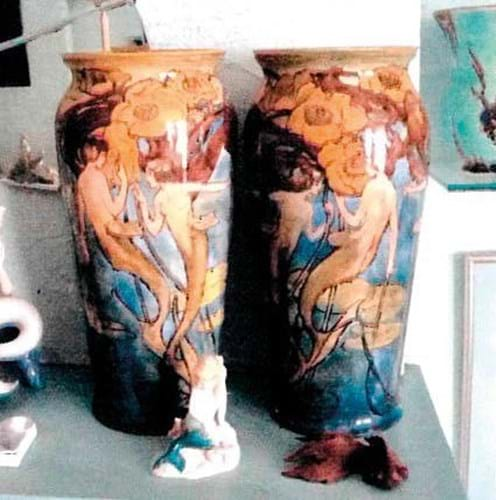
The pair of vases by Margaret Thompson acquired by Dr David Berry with a little help from ATG.
As a collector and long-standing subscriber to ATG, I have been able to acquire, through its information on auctions, often with illustrations, some of my most noticeable and cherished pieces; notably in 1986 from an auction in Bath, a large pair of vases by Margaret Thompson painted with mermaids and water lilies (pictured above).
Over the years the ATG has pointed me in many excellent directions, helping to enhance my collection. I look forward to it every week.
Dr David Berry
London N7
Here’s to the next 50 years
The past 50 years have flown by and looking back to 1971 it’s the equivalent of someone at the time casting their mind back to 1921.
Before 1971 one of the few ways that antiques dealers and collectors were able to ascertain which auction sales were taking place outside London, apart from the odd provincial auctioneers’ advertisements along with those of Christie’s and Sotheby’s for forthcoming sales in The Times and The Daily Telegraph on Mondays and Tuesdays, was to subscribe to the Romeike and Curtis Press cuttings service.
I well remember visiting an antiques dealer who regularly attended country auctions showing me a sheaf of individual advertisements cut out from the local newspapers, which at the time were sent out on a regular basis. Photocopiers were only just beginning to appear at the time.
The arrival of the ATG filled an immediate gap along with reports of prices achieved in the provincial sales, albeit usually with fairly brief descriptions sent in by the auctioneers.
Possibly initially some members of the antiques trade might have been upset at all this information now being so widely available!
Fortunately, working at Christie’s at the time of the arrival of the ATG I have been a reader since the start, reading the press office copy.
Later in the mid 1970s I was an advertiser and it was always a pleasure to look in at the office with my advertising copy and chat to Ivor Turnbull and Chris Jukes who looked after the advertising side, and then sometimes join them for a drink at the nearby pub.
In 2071 I wonder what technology will be around that will be difficult to live without; today how could we manage without mobile phones and iPads giving instant access to thesaleroom.com and past sales results?
Thank you ATG for the past 50 years. Best wishes for the next 50 years and your century.
John Hudson
Fine art specialist and previously at Christie’s and Sotheby’s
Big in Europe
I started my business in September 1972 and that is where I first met my soon to be friend Gordon Savage at The Bond Street Antique Centre. At this time he had started writing his weekly contribution at the beginning of this publication, and as I understood it was at that time unpaid.
I recall that the Gazette operated from a room above a musical instrument shop in Langley Street just off St Martins Lane before moving to new premises.
I myself owe these early editions the fact that two continental readers saw my advert and became loyal clients for many years, for which I thank you!
Michael German
Michael German Antiques
Kensington Church Street, London
Big Down Under
In London on one of my regular antique sorties from Australia, well back in the last century, I found myself talking to Phillip Broadridge. He, with Heather Collingwood, ran LAPADA from their offices in Knightsbridge.
It was Phillip who recommended that I subscribe to ATG. This was admirable advice which I took and have never regretted over some four decades.
What did the ATG offer all that time ago to someone living in Australia? It was invaluable for staying in touch and also for planning a visit to Europe, America or indeed anywhere overseas.
Important were the reports of sales, information about laws and regulations, lists of events and other trade developments. It was through the ATG one gained valuable and digestible ‘early warnings’ about the impact on the trade of VAT, buyer’s premium, the Kent Bill and so forth.
When planning an overseas trip, ATG was essential with its list of upcoming auctions, fairs, markets, museums and exhibition information. At all times, of course, it was also interesting and entertaining.
More recently, although topical issues may have changed to the likes of ivory, money laundering, ARR and Brexit contingencies, the ATG remains the same great asset for all the above reasons.
It is notable for the exceptionally high standard of antiques and art journalism across the board – from Leonardo to lamps and Chippendale to corkscrews (and all mediums in between).
The articles and reports of sales and items are professionally researched, concise and informative. Often included are useful references to comparable examples, historical background, provenance and other relevant circumstances surrounding the sale and purchase.
Radio star
While ideal (indeed essential) for myself and anyone else who is a trade professional, ATG is, perhaps unexpectedly, also perfectly suited for another purpose. Its content fits admirably with my radio programme, Antiques Radio Show (Sydney, 2RPH,100.5 FM, also podcast and streamed).
The programme is orientated towards those who cannot easily access print media through disability. This makes ATG a major contributor, not only to the trade itself, but also to the important issue of the inclusion of those whose access to the world of antiques and art would otherwise be limited or inhibited.
My own personal thanks to the ATG and also on behalf of all those included by being able to enjoy it on the Antiques Radio Show.
Jolyon Warwick James
Jolyon Warwick James Silver
Sydney, Australia
High flyer
My lifetime passion for antiques resulted from a childhood desire, inspired at the age of 12 or so, to see the wonderful 1960s Battle of Britain film Angels One Five.
A couple of bob, courtesy of my mum, got me into the Regent cinema, Horley, and I was hooked! All I wanted was to be a pilot. However, this was not to be so I had to settle for RAF navigator training instead.
In 1971, I married the lovely Gillian and like all newly weds in those days we had to live on base in married quarters furnished with solid but boring government furniture and with awful dreary wall decorations.
Fortunately, a change in policy somewhere higher up allowed us to furnish with our own fixtures and fittings. However, as an impoverished junior officer G-Plan was out of the question so started the quest for nice old things, which could be done up.
For our first-ever purchase, we acquired a fine quality, if shabby Victorian chaise longue, which once restored to former glory, was immediately bought by the station commander’s wife. We were off as embryonic dealers in antiques!
Antiques programmes with the then presenter Arthur Negus educated many, preceding the Antiques Roadshow by many years. I think we all remember Arthur as he caressed some piece of furniture or other, uttering a “just the way it was made”.
Learning the trade
My education in antiques really started through knowing and selling to David Hansord with a shop near ours on Steepe Hill. David, then as now, knew the business with a specialist knowledge second to none.
Of course, I was still a serving officer and in the 1970s I was at RAF Manby on the air warfare course. There I met a US exchange officer, Chick Garcia, who, just by chance, was a keen antiques collector. “You have to meet old Mr Sargisson,” he said.
Roy, as he was known, had inherited the large family farm after the war, and filled it with clocks in the ensuing years: they were up the stairs, in every room, dozens of them plus case after case of silver pocket watches and every sort of clock part. However, Roy could only do the movements, but was not a case restorer.
He had a number of oak church pews; so for the next few years, when not otherwise flying, I had a full-time job.
Setting up shop
I was out of the service in 1982, but with a pension and gratuity and living in a large bungalow in Ruskington, Linconshire. Part of the gratuity was immediately spent on a vacant shop in the village, which became Pinfold Antiques for the next 20 years.
In the course of buying antiques in Lincolnshire, I was to meet a young dealer from Boston, called Lawrence Shaw, who had his own shop and warehouse.
We spent a lot with Lawrence, and ultimately he joined me as his partner: him buying from every possible source for his own business, while passing on all the good pieces to me for retailing through attendance at antiques fairs.
Very quickly we attracted the attention of some big names in the business, and were invited to join the exhibitors in the inaugural Birmingham NEC international fair.
Fair attractions
It was about this time that I first met George Hadfield – an advertising and promotions executive who was putting his money into clocks in Shepshed, Leicestershire.
Being in advertising, it was natural that he extolled the virtues of the ATG, which continues to this day to be the most authoritative voice in antiques.
I well remember the first of many Olympia summer fairs. We arrived in Lawrence’s big removal van, but being ‘country cousins’ we were preyed on by all the London dealers, and most of our stock was purchased before it could reach the stand!
No bad thing, but we had to go straight back home for more. Lincolnshire longcase clocks were a big favourite – small painted dial oak and mahogany ones – often with moon phase dials. At this fair and the many later ones, we must have sold dozens.
American connection
Back in our shop on Steepe Hill, we really fell on good times. One rainy day, we met an American couple. The man was a senior executive in the offshore oil industry.
“It was nice to meet you, but just passing this time. We’ll be back,” he said.
A year later, and the same voice on a late Saturday afternoon said: “Are you open?” There began an amazing 10 years as Bob introduced us to countless US clients – selling longcase clocks in dozens.
In 1999, I wound up the business, just as the ghastly IKEA revolution started, resulting in devastation of the traditional mahogany furniture and clock trade, with subsequent prices a fraction of those pre-1999.
Twenty years on, I continue to buy at auction as traditional antiques prices have returned nearer the ‘golden days’ values, buying here and there the things which as far as possible are, in dear old Arthur’s words, “just the way they were made”.

